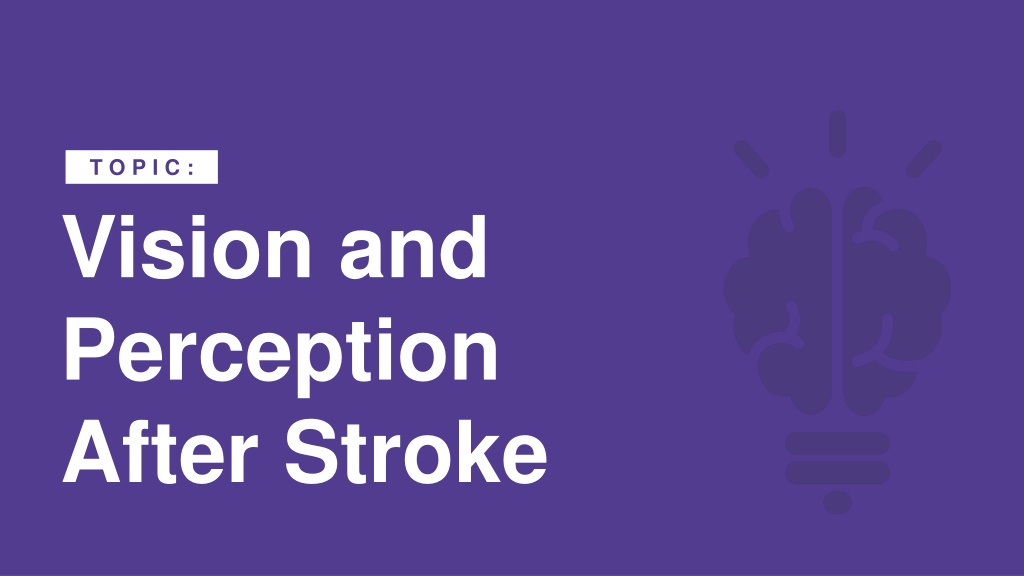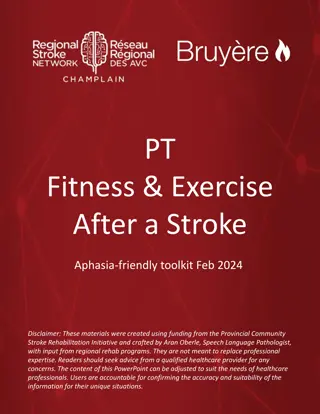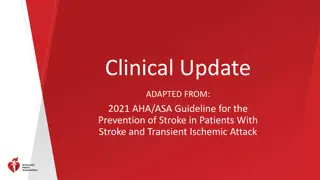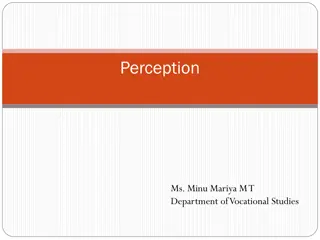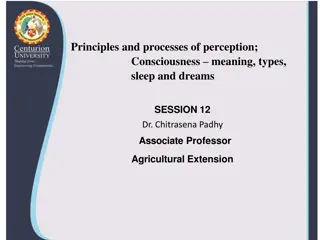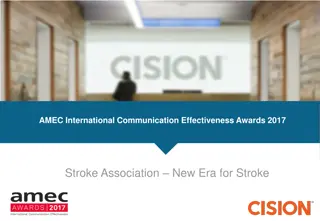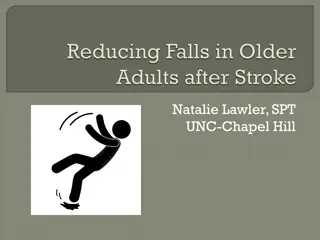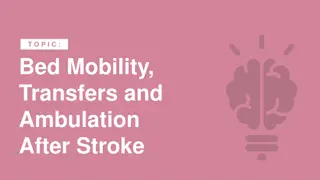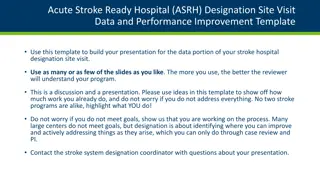Understanding Vision and Perception Changes After Stroke
Our brain processes information from our five senses to interpret our surroundings. Changes in vision and perception following a stroke can impact independence, safety, and emotional well-being. It's important to recognize these changes, as they may not be obvious and can lead to various challenges. Practical tips can help individuals cope with altered vision and minimize safety risks.
Download Presentation

Please find below an Image/Link to download the presentation.
The content on the website is provided AS IS for your information and personal use only. It may not be sold, licensed, or shared on other websites without obtaining consent from the author. Download presentation by click this link. If you encounter any issues during the download, it is possible that the publisher has removed the file from their server.
E N D
Presentation Transcript
T O P I C : Vision and Perception After Stroke
Vision and Perception After Stroke Our brain collects information through all five senses Perception is how our brain interprets information to understand our surroundings Changes in vision and perception can lead to loss of independence, safety risks and emotional distress 2
Vision and Perception After Stroke What you should know: When someone has changes to vision and perception it may: not be obvious be easy to overestimate the person s abilities impact mood and cause frustration lead to serious safety risks 3
Common Changes What is it Practical Example Smart Tips Lack of vision clarity or sharpness Use large print The person may: have difficulty reading have difficulty finding objects (e.g. white call bell on white sheets or white plate on white table) Blurry vision Create contrast where possible (e.g. use coloured tape on the call bell or dark placemat under white plate) VISION Seeing two images of a single object Most common - lack of vision in one half of each eye (hemianopsia) Reduce amount of items and space them out on bedside table The person may: have difficulty finding objects on a cluttered table Double vision (diplopia) Tell the person to scan using the Lighthouse Strategy (i.e. imagining the eyes as beams of light sweeping side to side) The person may: not see hazards in their environment causing them to bump into objects Visual field loss 5
Common Changes What is it Practical Example Smart Tips Lack of vision clarity or sharpness Use large print The person may: have difficulty reading have difficulty finding objects (e.g. white call bell on white sheets or white plate on white table) Blurry vision Create contrast where possible (e.g. use coloured tape on the call bell or dark placemat under white plate) VISION Seeing two images of a single object Most common - lack of vision in one half of each eye (hemianopsia) Reduce amount of items and space them out on bedside table The person may: have difficulty finding objects on a cluttered table Double vision (diplopia) Tell the person to scan using the Lighthouse Strategy (i.e. imagining the eyes as beams of light sweeping side to side) The person may: not see hazards in their environment causing them to bump into objects Visual field loss 6
Common Changes What is it Practical Example Smart Tips Lack of vision clarity or sharpness Use large print The person may: have difficulty reading have difficulty finding objects (e.g. white call bell on white sheets or white plate on white table) Blurry vision Create contrast where possible (e.g. use coloured tape on the call bell or dark placemat under white plate) VISION Seeing two images of a single object Most common - lack of vision in one half of each eye (hemianopsia) Reduce amount of items and space them out on bedside table The person may: have difficulty finding objects on a cluttered table Double vision (diplopia) Tell the person to scan using the Lighthouse Strategy (i.e. imagining the eyes as beams of light sweeping side to side) The person may: not see hazards in their environment causing them to bump into objects Visual field loss 7
Common Changes What is it Practical Example Smart Tips The inability to estimate the distance between two objects or between themselves and an object Add red tape on edge of table, sink or toilet seat Cue the person to use their sense of touch to help find items Minimize clutter in the space The person may: miss the chair when sitting down knock over a glass of water when reaching for it Depth perception PERCEPTION Decreased awareness of the body (e.g. forgetting their arm) and/or the environment on the person s affected side Bring their attention to the affected arm or plate of food so that they can see it Consider turning the plate or repositioning the arm Monitor their neglected side for pain, injury and skin abrasions Provide the correct tool, use hand-over hand guidance and do not take over the task unless necessary The person may: ignore half of their plate of food roll over onto their affected arm in bed or let their affected arm dangle by their side when sitting Neglect Difficulty completing actions the way the person wants or needs to, even though they are physically capable The person may: use a comb to brush their teeth hold the hairbrush, but not know how to start brushing their hair Apraxia 9
Common Changes What is it Practical Example Smart Tips The inability to estimate the distance between two objects or between themselves and an object Add red tape on edge of table, sink or toilet seat Cue the person to use their sense of touch to help find items Minimize clutter in the space The person may: miss the chair when sitting down knock over a glass of water when reaching for it Depth perception PERCEPTION Decreased awareness of the body (e.g. forgetting their arm) and/or the environment on the person s affected side Bring their attention to the affected arm or plate of food so that they can see it Consider turning the plate or repositioning the arm Monitor their neglected side for pain, injury and skin abrasions Provide the correct tool, use hand-over hand guidance and do not take over the task unless necessary The person may: ignore half of their plate of food roll over onto their affected arm in bed or let their affected arm dangle by their side when sitting Neglect Difficulty completing actions the way the person wants or needs to, even though they are physically capable The person may: use a comb to brush their teeth hold the hairbrush, but not know how to start brushing their hair Apraxia 10
Common Changes What is it Practical Example Smart Tips The inability to estimate the distance between two objects or between themselves and an object Add red tape on edge of table, sink or toilet seat Cue the person to use their sense of touch to help find items Minimize clutter in the space The person may: miss the chair when sitting down knock over a glass of water when reaching for it Depth perception PERCEPTION Decreased awareness of the body (e.g. forgetting their arm) and/or the environment on the person s affected side Bring their attention to the affected arm or plate of food so that they can see it Consider turning the plate or repositioning the arm Monitor their neglected side for pain, injury and skin abrasions Provide the correct tool, use hand-over hand guidance and do not take over the task unless necessary The person may: ignore half of their plate of food roll over onto their affected arm in bed or let their affected arm dangle by their side when sitting Neglect Difficulty completing actions the way the person wants or needs to, even though they are physically capable The person may: use a comb to brush their teeth hold the hairbrush, but not know how to start brushing their hair Apraxia 11
Vision and Perception After Stroke Smart Tips: Ensure supervision or assistance with transfers to promote safety Decrease clutter and keep space organized Slow down and give the person more time Be specific when giving instructions Remember: The individual s care plan may contain specific strategies Keep items in consistent locations 12
Vision and Perception After Stroke Enhance vision: well-lit environment, prescribed glasses For neglect and visual field loss, approach the person from the unaffected side and arrange items on their unaffected side For apraxia, use short, simple instructions and break tasks into smaller steps Educate family on how they can help the person 13
Vision and Perception After Stroke This document lists some examples of common visual and perceptual changes, but many more exist. Seek extra support Notify the team if you suspect any changes to vision and/or perception Optometrists and Ophthalmologists can provide assessment/management Occupational Therapists are skilled in vision and perception For more information, visit The Canadian National Institute for the Blind https://www.cnib.ca Smart Tips for Stroke Care (2023) was created by members of the Regional Stroke Networks of Ontario. This material may be shared without permission from the authors, without changes and with source credited. 14
